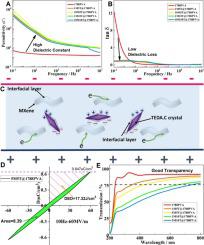当前位置:
X-MOL 学术
›
Colloids Surf. A Physicochem. Eng. Aspects
›
论文详情
Our official English website, www.x-mol.net, welcomes your
feedback! (Note: you will need to create a separate account there.)
Effects of ultralow concentration MXene (nano-Ti3C2Tx) on electric and physical properties in ternary polyvinyl alcohol composites
Colloids and Surfaces A: Physicochemical and Engineering Aspects ( IF 4.9 ) Pub Date : 2021-02-01 , DOI: 10.1016/j.colsurfa.2020.125929 Yunyun Yang , Yujia Liu , Xufu Cai
Colloids and Surfaces A: Physicochemical and Engineering Aspects ( IF 4.9 ) Pub Date : 2021-02-01 , DOI: 10.1016/j.colsurfa.2020.125929 Yunyun Yang , Yujia Liu , Xufu Cai

|
Abstract High-dielectric-constant (high-κ) fillers are embedded in polymer materials to improve the dielectric constant of polymer and form high-κ composites for the latest generation of energy storage devices. However, the addition of high-κ fillers will introduce interface polarization and cause space charge accumulations that will increase dielectric loss and reduce breakdown strength. Herein introduces a conductive MXene(nano-Ti3C2Tx) with high surface area to remarkably suppress space charge in polyvinyl alcohol (PVA) matrix. A ternary PVA composite with high dielectric constant and low dielectric loss is formed by doping with ultralow concentration MXene and soluble ferroelectric [Hdabco]ClO4 (TEDA.C) via solution mixing. The space charge suppression capability of MXene sharply reduces the dielectric loss of 1M@1788PVA and 5M@1788PVA (PVA with 0.0001 wt.% and 0.0005 wt.% MXene) at low frequency (0.1−10 Hz). By comparing the activation energy of dielectric relaxation (Ea) and breakdown strength (BDS) under AC electric field between pure PVA and PVA composites, ultralow concentration MXene declines the Ea of 1M@1788PVA and 5M@1788PVA by 26.8 % and 60.9 %, and effectively improves the BDS of 1M@1788PVA and 1M5T@1788PVA (PVA with 0.0001 wt.% MXene and 4.7 wt.% TEDA.C) by 3%. The addition of ultralow concentration MXene and TEDA.C bring 5M5T@1788PVA(PVA with 0.0005 wt.% MXene and 4.7 wt.% TEDA.C) highest discharged energy density(17.32 J/cm3)which is 1.53 times of that of 1788PVA.
中文翻译:

超低浓度MXene(纳米Ti3C2Tx)对三元聚乙烯醇复合材料电学和物理性能的影响
摘要 高介电常数(high-κ)填料嵌入聚合物材料中以提高聚合物的介电常数并形成用于最新一代储能装置的高κ复合材料。然而,添加高 κ 填料会引入界面极化并导致空间电荷积累,从而增加介电损耗并降低击穿强度。本文介绍了一种具有高表面积的导电 MXene(nano-Ti3C2Tx),以显着抑制聚乙烯醇 (PVA) 基质中的空间电荷。通过溶液混合掺杂超低浓度 MXene 和可溶性铁电体 [Hdabco]ClO4 (TEDA.C),形成具有高介电常数和低介电损耗的三元 PVA 复合材料。MXene 的空间电荷抑制能力显着降低了 1M@1788PVA 和 5M@1788PVA(含 0.0001 wt.% 和 0.0005 wt.% MXene 的 PVA)在低频(0.1-10 Hz)下的介电损耗。通过比较纯 PVA 和 PVA 复合材料在交流电场下的介电弛豫激活能 (Ea) 和击穿强度 (BDS),超低浓度 MXene 使 1M@1788PVA 和 5M@1788PVA 的 Ea 下降了 26.8% 和 60.9%,并且有效地将 1M@1788PVA 和 1M5T@1788PVA(含 0.0001 wt.% MXene 和 4.7 wt.% TEDA.C 的 PVA)的 BDS 提高了 3%。超低浓度MXene和TEDA.C的加入带来5M5T@1788PVA(0.0005 wt.% MXene和4.7 wt.% TEDA.C的PVA)最高放电能量密度(17.32 J/cm3),是1788PVA的1.53倍。通过比较纯 PVA 和 PVA 复合材料在交流电场下的介电弛豫激活能 (Ea) 和击穿强度 (BDS),超低浓度 MXene 使 1M@1788PVA 和 5M@1788PVA 的 Ea 下降了 26.8% 和 60.9%,并且有效地将 1M@1788PVA 和 1M5T@1788PVA(含 0.0001 wt.% MXene 和 4.7 wt.% TEDA.C 的 PVA)的 BDS 提高了 3%。超低浓度MXene和TEDA.C的加入带来5M5T@1788PVA(0.0005 wt.% MXene和4.7 wt.% TEDA.C的PVA)最高放电能量密度(17.32 J/cm3),是1788PVA的1.53倍。通过比较纯 PVA 和 PVA 复合材料在交流电场下的介电弛豫激活能 (Ea) 和击穿强度 (BDS),超低浓度 MXene 使 1M@1788PVA 和 5M@1788PVA 的 Ea 下降了 26.8% 和 60.9%,并且有效地将 1M@1788PVA 和 1M5T@1788PVA(含 0.0001 wt.% MXene 和 4.7 wt.% TEDA.C 的 PVA)的 BDS 提高了 3%。超低浓度MXene和TEDA.C的加入带来5M5T@1788PVA(0.0005 wt.% MXene和4.7 wt.% TEDA.C的PVA)最高放电能量密度(17.32 J/cm3),是1788PVA的1.53倍。有效地将1M@1788PVA和1M5T@1788PVA(含0.0001 wt.% MXene和4.7 wt.% TEDA.C的PVA)的BDS提高了3%。超低浓度MXene和TEDA.C的加入带来5M5T@1788PVA(0.0005 wt.% MXene和4.7 wt.% TEDA.C的PVA)最高放电能量密度(17.32 J/cm3),是1788PVA的1.53倍。有效地将1M@1788PVA和1M5T@1788PVA(含0.0001 wt.% MXene和4.7 wt.% TEDA.C的PVA)的BDS提高了3%。超低浓度MXene和TEDA.C的加入带来5M5T@1788PVA(0.0005 wt.% MXene和4.7 wt.% TEDA.C的PVA)最高放电能量密度(17.32 J/cm3),是1788PVA的1.53倍。
更新日期:2021-02-01
中文翻译:

超低浓度MXene(纳米Ti3C2Tx)对三元聚乙烯醇复合材料电学和物理性能的影响
摘要 高介电常数(high-κ)填料嵌入聚合物材料中以提高聚合物的介电常数并形成用于最新一代储能装置的高κ复合材料。然而,添加高 κ 填料会引入界面极化并导致空间电荷积累,从而增加介电损耗并降低击穿强度。本文介绍了一种具有高表面积的导电 MXene(nano-Ti3C2Tx),以显着抑制聚乙烯醇 (PVA) 基质中的空间电荷。通过溶液混合掺杂超低浓度 MXene 和可溶性铁电体 [Hdabco]ClO4 (TEDA.C),形成具有高介电常数和低介电损耗的三元 PVA 复合材料。MXene 的空间电荷抑制能力显着降低了 1M@1788PVA 和 5M@1788PVA(含 0.0001 wt.% 和 0.0005 wt.% MXene 的 PVA)在低频(0.1-10 Hz)下的介电损耗。通过比较纯 PVA 和 PVA 复合材料在交流电场下的介电弛豫激活能 (Ea) 和击穿强度 (BDS),超低浓度 MXene 使 1M@1788PVA 和 5M@1788PVA 的 Ea 下降了 26.8% 和 60.9%,并且有效地将 1M@1788PVA 和 1M5T@1788PVA(含 0.0001 wt.% MXene 和 4.7 wt.% TEDA.C 的 PVA)的 BDS 提高了 3%。超低浓度MXene和TEDA.C的加入带来5M5T@1788PVA(0.0005 wt.% MXene和4.7 wt.% TEDA.C的PVA)最高放电能量密度(17.32 J/cm3),是1788PVA的1.53倍。通过比较纯 PVA 和 PVA 复合材料在交流电场下的介电弛豫激活能 (Ea) 和击穿强度 (BDS),超低浓度 MXene 使 1M@1788PVA 和 5M@1788PVA 的 Ea 下降了 26.8% 和 60.9%,并且有效地将 1M@1788PVA 和 1M5T@1788PVA(含 0.0001 wt.% MXene 和 4.7 wt.% TEDA.C 的 PVA)的 BDS 提高了 3%。超低浓度MXene和TEDA.C的加入带来5M5T@1788PVA(0.0005 wt.% MXene和4.7 wt.% TEDA.C的PVA)最高放电能量密度(17.32 J/cm3),是1788PVA的1.53倍。通过比较纯 PVA 和 PVA 复合材料在交流电场下的介电弛豫激活能 (Ea) 和击穿强度 (BDS),超低浓度 MXene 使 1M@1788PVA 和 5M@1788PVA 的 Ea 下降了 26.8% 和 60.9%,并且有效地将 1M@1788PVA 和 1M5T@1788PVA(含 0.0001 wt.% MXene 和 4.7 wt.% TEDA.C 的 PVA)的 BDS 提高了 3%。超低浓度MXene和TEDA.C的加入带来5M5T@1788PVA(0.0005 wt.% MXene和4.7 wt.% TEDA.C的PVA)最高放电能量密度(17.32 J/cm3),是1788PVA的1.53倍。有效地将1M@1788PVA和1M5T@1788PVA(含0.0001 wt.% MXene和4.7 wt.% TEDA.C的PVA)的BDS提高了3%。超低浓度MXene和TEDA.C的加入带来5M5T@1788PVA(0.0005 wt.% MXene和4.7 wt.% TEDA.C的PVA)最高放电能量密度(17.32 J/cm3),是1788PVA的1.53倍。有效地将1M@1788PVA和1M5T@1788PVA(含0.0001 wt.% MXene和4.7 wt.% TEDA.C的PVA)的BDS提高了3%。超低浓度MXene和TEDA.C的加入带来5M5T@1788PVA(0.0005 wt.% MXene和4.7 wt.% TEDA.C的PVA)最高放电能量密度(17.32 J/cm3),是1788PVA的1.53倍。











































 京公网安备 11010802027423号
京公网安备 11010802027423号